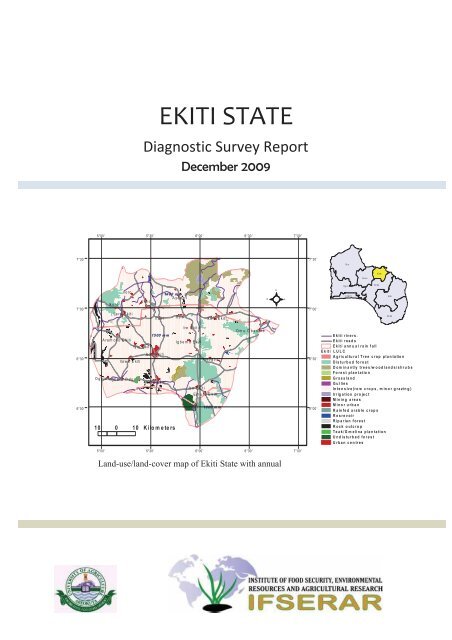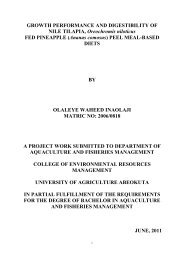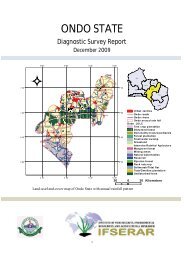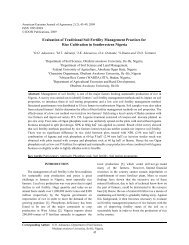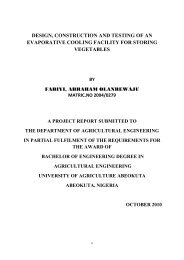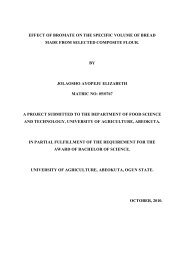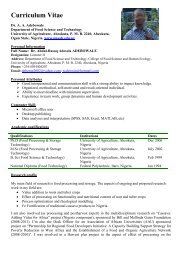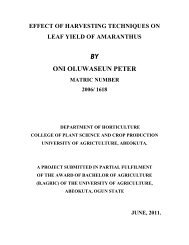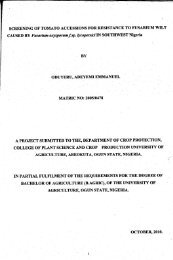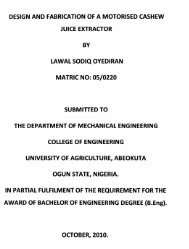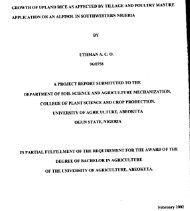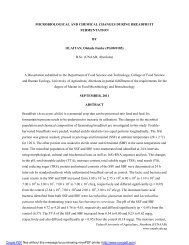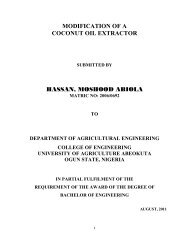EKITI STATE - The Federal University of Agriculture, Abeokuta
EKITI STATE - The Federal University of Agriculture, Abeokuta
EKITI STATE - The Federal University of Agriculture, Abeokuta
Create successful ePaper yourself
Turn your PDF publications into a flip-book with our unique Google optimized e-Paper software.
<strong>EKITI</strong> <strong>STATE</strong><br />
Diagnostic Survey Report<br />
December 2009<br />
500'<br />
530'<br />
600'<br />
630'<br />
700'<br />
730'<br />
730'<br />
Oy o<br />
Ekiti<br />
Os un<br />
Og un<br />
On do<br />
700'<br />
Iko r o<br />
Ilo ro<br />
Ijero Ekiti<br />
Ushi<br />
1400 m m<br />
Ayede<br />
Ifa ki Oye<br />
Iko le E kiti<br />
W<br />
N<br />
S<br />
E<br />
700'<br />
La go s<br />
Edo<br />
De lta<br />
630'<br />
600'<br />
Ire E kiti<br />
1500 m m<br />
Aram oko Ekiti<br />
Ig b e m o E k iti<br />
Iyin Ekiti<br />
Ado Ekiti<br />
Aisegba<br />
Ila w e E kiti<br />
OgotunIg b a ra O d o<br />
Ike r e E k iti<br />
Ise E k iti<br />
Emure Ekiti<br />
1600 m m<br />
10 0 10 Kilometers<br />
Om u Obadore<br />
630'<br />
600'<br />
E k it i riv e rs .<br />
E k it i roa d s<br />
E k it i a nn u a l ra in f a ll<br />
E k it i L U L C<br />
Agricultural Tree crop plantation<br />
Disturbed forest<br />
Dom inantly trees/woodlands/shrubs<br />
Forest plantation<br />
Grassland<br />
Gullies<br />
Intensive(row crops, minor grazing)<br />
Irrigation project<br />
Mining areas<br />
Minor urban<br />
R a in fe d a ra b le c rop s<br />
Resrevoir<br />
Riparian forest<br />
Rock outcrop<br />
Teak/G m elina plantation<br />
Undisturbed forest<br />
Urban centres<br />
500'<br />
530'<br />
600'<br />
630'<br />
Land-use/land-cover map <strong>of</strong> Ekiti State with annual<br />
700'
<strong>EKITI</strong> <strong>STATE</strong><br />
Diagnostic Survey Report<br />
December 2009<br />
ii
© UNAAB-IFSERAR, 2010<br />
ISBN 978-978-50092-3-1<br />
<strong>EKITI</strong> <strong>STATE</strong><br />
Diagnostic Survey Report<br />
December 2009<br />
Published by:<br />
Institute <strong>of</strong> Food Security, Environmental Resources and Agricultural Research<br />
<strong>University</strong> <strong>of</strong> <strong>Agriculture</strong><br />
P.M.B. 2240<br />
<strong>Abeokuta</strong><br />
Nigeria<br />
Tel.: +2348064779102<br />
e-mail: ifserar.unaab@yahoo.com<br />
website: www.unaab.edu.ng/ifserar<br />
iii
REPORT OF DIAGNOSTIC SURVEY CONDUCTED IN <strong>EKITI</strong><br />
<strong>STATE</strong>, SOUTHWESTERN NIGERIA<br />
BY<br />
J. M. AWOTUNDE - AERD, COLAMRUD<br />
O. OGUNTOKE - EMT, COLERM<br />
T. A. OLAIFA - CGNS, COLAMRUD<br />
O. T. ADENUBI - PHARMVET, COLVET<br />
UNIVERSITY OF AGRICULTURE, ABEOKUTA<br />
SUBMITTED TO<br />
RESEARCH AND DEVELOPMENT CENTRE (RESDEC)<br />
UNIVERSITY OF AGRICULTURE, ABEOKUTA<br />
iv
ACRONYMS<br />
1. ADP - Agricultural Development Programme<br />
2. AERD - Agricultural Extension and Rural Development (Dept in<br />
UNAAB)<br />
3. AMREC - Agricultural Media Resources and Extension Centre in<br />
UNAAB<br />
4. CGNS - Communications and General Studies (Dept in UNAAB)<br />
5. COLAMRUD - College <strong>of</strong> Agricultural Management and Rural<br />
Development<br />
6. COLERM - College <strong>of</strong> Environmental Resources and Management (in<br />
UNAAB)<br />
7. COLVET - College <strong>of</strong> Veterinary Medicine (in UNAAB)<br />
8. EKADEP - Ekiti State Agricultural Development Programme<br />
9. EKSG - Ekiti State Government<br />
10. EMT - Environmental Management and Toxicology (Dept in<br />
UNAAB)<br />
11. FADAMA - Hausa Language for Swamp or Wet Land used for dry<br />
season cropping<br />
12. FDG - Focus Group Discussion<br />
13. NERICA - New Rice for African Dissemination Project<br />
14. NIHORT - National Horticultural Research Institute, Ibadan<br />
15. NSPFS - National Special Programme for Food Security<br />
16. PHARMVET - Pharmacology Veterinary (Dept in UNAAB)<br />
17. PRA - Participatory Rural Appraisal<br />
18. RESDEC - Research and Development Centre (in UNAAB)<br />
19. UNAAB - <strong>University</strong> <strong>of</strong> <strong>Agriculture</strong>, <strong>Abeokuta</strong><br />
v
TABLE OF CONTENTS<br />
Cover page<br />
iv<br />
v<br />
vi<br />
1.0 INTRODUCTION 1<br />
1.1 Backgro 1<br />
1.2 1<br />
1.3 2<br />
2.0 RESEARCH METHODOLOGY 2<br />
2.1 2<br />
2.2 Sampling and data collection<br />
4<br />
..<br />
3.0 DATA AND FINDINGS 5<br />
31 5<br />
3.2 9<br />
3.3 9<br />
3.4 10<br />
3. 5 10<br />
3.2 CROP/LIVESTOCK 10<br />
3.2.1 11<br />
3.2.2 11<br />
3.2.3 11<br />
3.2.4 Frequ 11<br />
4.0 AREAS OF INTERVENTION 12<br />
4.1 12<br />
5.0 CONSTRAINTS/PROBLEMS IN AGRICULTURE 13<br />
6.0 CONCLUSION AND RECOMMENDATION 13<br />
REFERENCE 14<br />
APPENDIX 15<br />
vi
LIST OF TABLES<br />
Table 1 3<br />
Table 2 4<br />
Table 3 Total number <strong>of</strong> Focus Group Discussion (FGD) Participants according 5<br />
To EKADEP s<br />
Table 4 7<br />
Table 5 8<br />
Table 6 9<br />
Table 7 Yiel 10<br />
vii
APPENDIX<br />
i Ekiti State Agricultural Development Programme Ikole 15<br />
ii Ekiti State Agricultural Development Programme National Programme for<br />
Food Security (NFFS) First Qu<br />
24<br />
iii<br />
iv<br />
v<br />
Ekiti State Agricultural Development Programme National Programme for<br />
<br />
Ekiti State Agricultural Development Programme, National Programme for<br />
<br />
Ekiti State Agricultural Development Programme Status Report <strong>of</strong> ADP<br />
(2007 <br />
vi Agricultural Performance Survey <strong>of</strong> 2008 Wet Season in Nigeria (Ekiti State 70<br />
Report) <br />
vii 98<br />
viii 122<br />
ix Driving Direction for Ekiti 123<br />
x 124<br />
xii Land-use/Land- 125<br />
40<br />
48<br />
60<br />
viii
1.0 INTRODUCTION<br />
1.1 Background <strong>of</strong> the Study<br />
<strong>The</strong> <strong>University</strong> <strong>of</strong> <strong>Agriculture</strong>, <strong>Abeokuta</strong> (UNAAB) was established in 1998 by<br />
the <strong>Federal</strong> Government <strong>of</strong> Nigeria, with the tripodal mandate <strong>of</strong> teaching, research and<br />
extension (UNAAB 2007). <strong>The</strong> <strong>University</strong> (UNAAB) has a direct responsibility <strong>of</strong><br />
conducting research and extension services in her mandate States which comprise <strong>of</strong><br />
Ogun, Oyo, Ondo, Osun, Ekiti, Lagos, Edo and Delta States.<br />
Agricultural development policies <strong>of</strong>ten follow top-down approach with varying<br />
levels <strong>of</strong> failure. To provide a remedy for this situation, a reversal <strong>of</strong> policy structure and<br />
strategy is required. It is in this light that the <strong>University</strong> <strong>of</strong> <strong>Agriculture</strong>, <strong>Abeokuta</strong> geared<br />
up efforts to identify the agricultural problems and needs <strong>of</strong> the farmers in the mandate<br />
States using bottom-up approach which is participatory in nature.<br />
<strong>The</strong> participatory rural appraisal (PRA) techniques involve the active participation<br />
<strong>of</strong> rural community dwellers being targeted (Nabasa et al., 1995)<br />
<strong>The</strong> PRA techniques are indeed useful in discovering, weighing and prioritizing<br />
problems and needs as presented by groups <strong>of</strong> farmers technically known as Focus Group<br />
Discussion (FGD) participants; during the early stages <strong>of</strong> identifying and setting the<br />
research agenda.<br />
1.2 Problem Statement<br />
<strong>The</strong> <strong>Federal</strong> Government <strong>of</strong> Nigeria established various Agricultural Research<br />
Institutes and Universities to tackle the problems <strong>of</strong> agricultural production within their<br />
catchment areas in form <strong>of</strong> developing research agenda. <strong>The</strong> <strong>University</strong> <strong>of</strong> <strong>Agriculture</strong>,<br />
<strong>Abeokuta</strong> (UNAAB), being one <strong>of</strong> them conducted a survey in the early 1990s but the<br />
attempted efforts have not reflected positively on agricultural production <strong>of</strong> farmers<br />
within the States. Although enviable heights seemed to have been attained in its<br />
academic endeavours, the research and extension arm are still largely unfulfilled.<br />
A lot has been attributed to lack <strong>of</strong> funds, and inappropriate technologies,<br />
inconsistent policies which have inadvertently impacted negatively on research and<br />
extension services. Farmers still face myriad <strong>of</strong> problems such as lack <strong>of</strong> access roads,<br />
poor funding, use <strong>of</strong> crude implements, non-availability <strong>of</strong> improved inputs and post<br />
1
harvest losses due to poor storage facilities. <strong>The</strong>se problems have direct or indirect<br />
poor<br />
<br />
<br />
Southwestern region <strong>of</strong> Nigeria. All these betray the research gap(s) in agriculture in the<br />
mandate States.<br />
1.3 Survey Objectives<br />
<strong>The</strong> broad objective <strong>of</strong> this diagnostic survey study is to determine the research<br />
gap(s) in agriculture, the problems and needs <strong>of</strong> farmers in Ekiti State as a prelude to<br />
conducting appropriate research to address them within the context <strong>of</strong> overall national<br />
development.<br />
<strong>The</strong> specific objectives <strong>of</strong> the study are to:<br />
(1) Identify the basic social and economic characteristics <strong>of</strong> the farmers in Ekiti State.<br />
(2) Identify the farm activities and the common practices.<br />
(3) Identify the basic problems in farming in Ekiti State.<br />
(4) Identify the available technologies in farming in the State.<br />
(5) Describe the role <strong>of</strong> other institutions in the area <strong>of</strong> agriculture in the State.<br />
(6) Draw conclusion and action plans.<br />
2.0 RESEARCH METHODOLOGY<br />
2.1 Study Area<br />
<strong>The</strong> PRA diagnostic survey study was conducted in Ekiti State, being one <strong>of</strong> the<br />
mandate States <strong>of</strong> the <strong>University</strong> <strong>of</strong> <strong>Agriculture</strong>, <strong>Abeokuta</strong>.<br />
Ekiti State, created on 1 st October 1996, was carved out <strong>of</strong> the old Ondo State. It<br />
is located between Longitude 4 0 0 <br />
Latitudes 7 0 0 5 North <strong>of</strong> the Equator (EKSG, 2009). <strong>The</strong> State is a relatively<br />
young State requiring enormous resources to advance its development.<br />
<strong>The</strong> vegetation <strong>of</strong> Ekiti State is guinea forest with its attendant climate, flora and<br />
fauna. <strong>The</strong> State is homogenous in ethnic composition originally, but other tribes (Ebira,<br />
Nupe, Igede, Urhobo, Igala, Ibo and Hausa) now abound.<br />
2
<strong>Agriculture</strong> is the main occupation <strong>of</strong> Ekiti people and it is the major source <strong>of</strong><br />
income for many in the State. <strong>Agriculture</strong> provides income and employment for more<br />
than 75% <strong>of</strong> the population <strong>of</strong> Ekiti State (EKSG, 2009)<br />
<strong>The</strong> main cash crops are cocoa, c<strong>of</strong>fee, kolanut, cashew and oil palm. Other crops<br />
include citrus, fruits, coconut, mango, sugarcane, guava and pineapple. <strong>The</strong> state can also<br />
boast <strong>of</strong> various species <strong>of</strong> timber that provide raw materials for wood-based industries<br />
(Table 1).<br />
Food crops that abound in the State include yam, cocoyam, maize,<br />
plantain/banana, rice, beans, tomatoes and varieties <strong>of</strong> vegetables (Table 2).<br />
Table 1: Cash Crop widely cultivated in Ekiti State<br />
S/N Crop Location Uses<br />
1 Cocoa Ise, Emure, Ilawe, Ado, Igede, Igbara Odo, Cocoa butter, Cocoa<br />
Aramoko, Ikoro<br />
Powder, Beverages, Cocoa<br />
Liquor and Export<br />
2 Oil Palm Spread across the state Vegetable Oil, Spices,<br />
Flavoring and Export<br />
3 Kola Nut Ikoro, Igede, Ise and generally in the forest Stimulants and export<br />
zone<br />
4 Plantain/ Widespread across the state Plantain Flour, Plantain<br />
Banana<br />
Beer, Plantain Balls and<br />
Chips/Crape<br />
5 Cashew Northern part <strong>of</strong> the state Oil, Nut and for export<br />
6 Citrus Widespread across the state Fruit juice, Fruit wine and<br />
for export<br />
7 Timber Southern part <strong>of</strong> the state Tyre manufacturing, Crepe<br />
and for export<br />
8 Timber Ijero, Ise, Ikere, Aramoko, Ado, Ilawe Log, Planks, Panel Furniture<br />
and for export<br />
3
Table 2:<br />
Arable Crops widely cultivated in Ekiti State<br />
S/N Crop Highly Cultivated LGAs Industrial Uses/Products<br />
1 Rice Irepodun/Ifelodun Ekiti West, Ikole, Ekiti Flour, Grits, Grains<br />
East<br />
2 Yam Widely cultivated across the State Yam Flour<br />
3 Cassava Widely cultivated across the State Garri, Starch, Adhesive,<br />
Mosquito Expeller,<br />
Livestock Feeds, Chips,<br />
Yeast, Alcohol Products<br />
4 Maize Widely cultivated across the State Maize, Grit, Corn Flour<br />
5 Cowpea Northern Part <strong>of</strong> the State Grits, Flour<br />
6 Plantain & Widely cultivated Plantain Flour, Plantain<br />
Banana<br />
Chips/Crepe, Plantain Juice<br />
and Beer<br />
Food culture and habit is roots and tubers based, but cereals, plantain, bananas are also<br />
significant crops in the State. Mixed cropping is predominant and aquaculture practice is<br />
growing rapidly. Goats, sheep and bush meat are preferred delicacies. <strong>The</strong> soil is fertile,<br />
but the use <strong>of</strong> fertilizers has increased remarkably in recent times. Among the tree crops<br />
cultivated in the State, the most important are cocoa, oil palm and citrus.<br />
2.2 Sampling and Data Collection<br />
<strong>The</strong> multi-stage sampling technique was used to select the village groups. <strong>The</strong><br />
two EKADEP zones were used and three blocks were randomly selected from zone 1 and<br />
two blocks from zone 2. One to six extension village groups were randomly selected<br />
from each block which gave a total <strong>of</strong> twenty-two village groups (Table 3). Information<br />
was elucidated from the Focus Group Discussion participants with the use <strong>of</strong> a<br />
standardized diagnostic survey interview guide. <strong>The</strong> field research work was carried out<br />
from 7 th to 11 th December, 2009.<br />
4
3.0 DATA AND FINDINGS<br />
This section presents the data obtained and discusses the findings, during the PRA<br />
field work in Ekiti State. Data on the characteristics <strong>of</strong> the participants at the Focus<br />
Group Discussion (FGD) along gender lines, to include the total number <strong>of</strong> male and<br />
female, the major tribes <strong>of</strong> the communities, their age brackets, primary and secondary<br />
occupations were presented in this section.<br />
3.1 <br />
A.1 Table 3 presents the total number <strong>of</strong> Focus Group Discussion participants<br />
according to EKADEP zones and sites which consist <strong>of</strong> homogeneous villages. Majority<br />
(76.7%) <strong>of</strong> the overall number <strong>of</strong> participants were male while the female participants<br />
were less than one quarter (23.3%). This data implies that more men than women are<br />
actively involved in farming activities in Ekiti State.<br />
EKADEP<br />
ZONES<br />
1 (a)<br />
(b)<br />
(c)<br />
2 (a)<br />
(b)<br />
Table 3:<br />
Total Number <strong>of</strong> Focus Group Discussion (FGD) participants<br />
according to EKADEP Sites<br />
BLOCK<br />
OFFICE<br />
FOCUS GROUP DISCUSSION SITE AND VILLAGES<br />
FGD<br />
FGD VILLAGES<br />
SEX<br />
SITES<br />
M F TOTAL<br />
Iddo/Osi Block Orin site Ifaki, Orin, Ora, Aaye, Ifisin,<br />
Igbole 30 9 39<br />
Iddo site Iddo, Usin, Ayetoro, Ilogbo, Osi,<br />
13 1 14<br />
Aramoko Aramoko Ile Ona, Ikogosi, Aramoko<br />
Block<br />
Site<br />
10 2 12<br />
Efon<br />
Efon-Alaaye Obake, Iwaji, Efon, Itawure<br />
site<br />
10 5 15<br />
Ikole Block Odo-Oro Ikole, Odo-Oro<br />
Site<br />
11 4 15<br />
Ode-Agbado Ode site Ode 6 - 6<br />
Block<br />
Agbado site Agbado 9 6 15<br />
Total 89 27 116<br />
TOTAL MALE = 89 (76.7%)<br />
TOTAL FEMALE = 27 (23.3%)<br />
5
A.2 <strong>The</strong> major tribes in the State is the Yoruba ethnic group (especially <strong>of</strong> Ekiti<br />
dialect) while other tribes namely Ebira, Nupe, Igede, Urhobo, Igala, Ibo and Hausa were<br />
also observed as migrant farmers in the State, who also formed the bulk <strong>of</strong> farm labour.<br />
A.3 <strong>The</strong> list <strong>of</strong> social infrastructures available in the FGD Communities in Ekiti State<br />
is presented on Table 4.<br />
6
Table 4: Infrastructural Facilities Status <strong>of</strong> the Selected Villages / Sites<br />
S/N<br />
FGD<br />
Location/Village<br />
Primary<br />
Schools<br />
Secondary<br />
Schools<br />
Post Sec.<br />
Schools<br />
Churches<br />
Mosques<br />
Shrines<br />
Petrol<br />
Station<br />
Pry Health<br />
Centre<br />
Maternity<br />
Medicine<br />
Shop<br />
Pharmacy<br />
Zone 1<br />
Ifaki 8 2 1 45 4 10 5 5 4 30 -<br />
1.<br />
2. Orin 4 1 - 15 1 4 1 2 2 -<br />
3. Ora 13 1 - 7 1 4 1 2 3 -<br />
4. Aaye Aaye 2 1 - 7 1 4 - 1 2 -<br />
5. Ifisin 2 1 - 8 1 3 - 1 2 -<br />
6. Igbole 2 1 - 8 1 4 - 1 3 -<br />
7. Iddo<br />
8. Usin<br />
9. Ayetoro<br />
10. Ilogbo<br />
11. Osi<br />
12. Ile Ona 4 2 - 4 4 - - 4 1 2 -<br />
13. Ikogosi 6 2 - 18 6 - - 5 1 6 -<br />
14. Aramoko 16 6 1 50 8 9 7 11 2 100 1<br />
15. Obake 2 - - 4 1 1 - 1 - - -<br />
16. Iwaji 2 - - 2 1 1 - 1 1 1 -<br />
17. Efon-Alaye 50 16 - 102 3 8 4 10 20 50 1<br />
18. Itawure 3 1 - 4 1 1 2 1 1 1 -<br />
Zone 2<br />
19. Ode 10 5 - 30 2 15 1 3 3 3 -<br />
20. Agbado 14 3 - 48 7 10 2 4 2 8 -<br />
21. Odo-Oro 5 2 - 12 5 3 1 2 1 8 1<br />
22. Isaba 6 1 - 10 1 1 - 1 1 -<br />
23. Ayedun 10 3 - 20 1 - 2 2 1 -<br />
24. Asin 6 4 - 30 1 1 - 2 - -<br />
25. Ushin 5 - - 10 - - 1 - - -<br />
26. Ikole<br />
One striking observation is that is no village community that does not have<br />
schools (especially primary schools). <strong>The</strong> people value and pursue education<br />
<br />
7
A.4 <strong>The</strong> coordinates <strong>of</strong> the communities taken and recorded during the field research<br />
work are presented on Table 5 below.<br />
Table 5: Coordinates <strong>of</strong> Selected FGD Locations in Ekiti State<br />
S/N Location/Site Northern Eastern Altitude<br />
1.<br />
2.<br />
3.<br />
4.<br />
5.<br />
6.<br />
7.<br />
8.<br />
9.<br />
10.<br />
11.<br />
12.<br />
13.<br />
14.<br />
15.<br />
16.<br />
Agbado (Isharun Qtrs)<br />
Resident <strong>of</strong> ADP Agent<br />
Ext. Block Office (Ode) Ode-Ekiti<br />
Palm Oil Press (Oyo)<br />
Ilu Omoba-Ekiti<br />
Aramoko (ADP) Office<br />
Itawure<br />
Efon-Alaaye (Hall)<br />
Odo-Oro (Hall)<br />
Orin Ekiti (Village)<br />
Nearest tarred Road<br />
Iddo Ekiti<br />
Ora Ekiti<br />
Aaye Ekiti<br />
Ifaki<br />
Odo Oro (Village town)<br />
ADP Hqtrs (Ikole-Ekiti)<br />
Min. <strong>of</strong> Agric. (Ado-Ekiti)<br />
7.59077<br />
7.58960<br />
7.64676<br />
7.64677<br />
7.71109<br />
7.72613<br />
7.65135<br />
7.83273<br />
7.83274<br />
7.83150<br />
7.84518<br />
7.82085<br />
7.80288<br />
7.78821<br />
7.78878<br />
7.80375<br />
7.63330<br />
5.51679<br />
5.51996<br />
5.56082<br />
5.42315<br />
5.03291<br />
4.95239<br />
4.92206<br />
5.52142<br />
5.23880<br />
5.23687<br />
5.18172<br />
5.21957<br />
5.21886<br />
5.24353<br />
5.52142<br />
5.49787<br />
5.20180<br />
392m<br />
380m<br />
413m<br />
379m<br />
575m<br />
441m<br />
561m<br />
590m<br />
568m<br />
575m<br />
580m<br />
572m<br />
578m<br />
578m<br />
590m<br />
564m<br />
454m<br />
A.5 Means <strong>of</strong> transportation available to the farmers in the FGD communities were<br />
mainly commercial motorcycles (popularly known as Okada) and motor cars. <strong>The</strong><br />
<br />
the markets. A few (5%) still use bicycles.<br />
A.6 Age category <strong>of</strong> FGD participants along gender line.<br />
Table 6 below shows the age category <strong>of</strong> the FGD participants.<br />
8
Table 6: Age category <strong>of</strong> FGD participants<br />
FGD<br />
Below 30years 31 50 years 75% Total<br />
Sites<br />
Male Female Male Female Male Female<br />
Orin 1 - 9 6 19 2 37<br />
Iddo 0 0 8 1 6 0 15<br />
Aramoko 0 0 5 1 3 0 9<br />
Efon-Alaaye 1 0 3 2 7 5 18<br />
Odo-Oro 0 0 7 4 4 0 15<br />
Ode 0 0 2 0 4 0 6<br />
Agbado 0 0 5 1 4 5 15<br />
Total (%) 2<br />
(1.7%)<br />
0<br />
(0)<br />
39<br />
(33.9%)<br />
15<br />
(13.1%)<br />
47<br />
(40.9%)<br />
12<br />
(10.4%)<br />
115<br />
(100%)<br />
A.7 Primary Occupation <strong>of</strong> the FGD participants<br />
<strong>The</strong> primary occupation <strong>of</strong> the FGD participants in Ekiti State is farming (60% to<br />
70%), while the secondary occupation include artisan (20%), trading (10%), civil<br />
servants (10%), hunting (3% - 10%) and labourer (2%). All the FGD female participants<br />
d processing. All their children that are<br />
<strong>of</strong> school age were all in schools; as education is given high priority in the State.<br />
A.8 Type <strong>of</strong> training common to the farmers<br />
<strong>The</strong> FGD participants received regular trainings on their agricultural production<br />
crops, livestock, beekeeping, snail rearing, and management <strong>of</strong> micro-credits/loans given<br />
them. <strong>The</strong>se trainings were organized and conducted by the Ekiti State Agricultural<br />
Development Programme (EKADE), NIHORT, FADAMA and National Programme on<br />
Food Security (NPFS).<br />
A.9 Average yield from crop<br />
<strong>The</strong> average yield in metric tonne per hectare <strong>of</strong> the major crops grown in Ekiti is<br />
shown on Table 7.<br />
9
Table 7 Yield (mt per Ha)<br />
S/N Crop Name 2007/2008<br />
Dry season<br />
2008<br />
Wet<br />
season<br />
Total<br />
2008<br />
2008/2009<br />
Dry season<br />
2009 Wet<br />
season<br />
Total<br />
2009<br />
% Change<br />
Dry<br />
season<br />
A Root and Tubers<br />
Cassava 19.06 19.06<br />
Yam 18.65 18.65<br />
Cocoyam 11.5 11.5<br />
Sweet Potato 7.3 7.3<br />
B Cereals<br />
Maize 2.16 2.1 2.1 2.08 2.08 -3.7 -0.95<br />
7 Rice 1.79 2 2 1.75 1.75 -2.23 -12.5<br />
C8 Legumes<br />
9 Cowpea 1.33 1.33 1.79 1.79 34.59<br />
10 Soyabean 1.3 1.3 5.4 5.4 315.38<br />
D Others<br />
1 Melon 1.64 1.64 2.27 2.2.7 38.41<br />
2 Leafy Vegetable 4.86 4.34 4.57 4.69 4.69 -3.5 2.63<br />
3 Okro 3.4 4.19 3.83 3.13 3.13 -7.94 -18.28<br />
4 Tomato 3.12 3.1 3.1 2.84 2.84 -8.97 -8.39<br />
5 Pepper 1.25 1.25 1.8 1.8 44<br />
6 Lettuce 1.91 1.91 1.39 1.39 -27.23 -27.23<br />
%<br />
Change<br />
Wet<br />
season<br />
% Change<br />
Total<br />
10
A.10 Primary and Secondary Sources <strong>of</strong> Income<br />
<br />
earnings on crops and livestock sales, while the secondary sources <strong>of</strong> their income come<br />
from micro-credits and loans from State governments, NPFS, FADAMA programmes.<br />
A. 11 Credit Sources for farming<br />
<strong>The</strong> credit sources for farming in the FGD locations in Ekiti State include Interest<br />
free micro-credits or loans from State governments, NPFS, ADP, NERICA rice project.<br />
3.2 Crop/Livestock<br />
<strong>The</strong> crops produced in the study area include maize, cassava, white yam, water<br />
yam, plantain, banana, oil palm, cocoyam, tomato, rice (NERICA project), beans, melon,<br />
cocoa, orange, pineapple, pawpaw, walnut, sugarcane, kolanut, mushroom, fluted<br />
pumpkin (Ugwu), Economic <br />
<br />
Livestock include Cattle, sheep, goat, duck, chicken (fowl), rabbit, pigs (Piggery).<br />
Farm implements/equipments mainly utilized by the FGD include mostly crude<br />
implements like hoes and cutlasses.<br />
3.2.1 Sources <strong>of</strong> Farm Inputs in the FGD<br />
(a) Hoes and cutlasses are bought by farmers from the markets.<br />
(b) Fertilizers and pesticides are being purchased from private individuals and retail<br />
shops. Inputs are therefore expensive for the FGD participants. <strong>The</strong>y suggested<br />
that EKADEP should be allowed to handle agricultural inputs distribution to<br />
Farmers.<br />
(c) Seeds and seedlings are distributed by EKADEP in collaboration with<br />
Agricultural Input Supply Company (AISC).<br />
11
3.2.2 Forest and Wildlife Products<br />
Indigenous trees in Ekiti State include Iroko, Mahogany (Khaya spp), Obeche<br />
(Triplochiton spp), Orin dudu (Eki), Teak.<br />
3.2.3 Fisheries Practices and Species<br />
<strong>The</strong>re is presently no river body or lake in Ekiti State hence existing fishery<br />
practices includes mainly the use <strong>of</strong> fish ponds mostly by medium scale fish producers.<br />
Aquaculture practices for producing Cat fish mainly is being engaged in by very few<br />
farmers.<br />
3.2.4 Frequency <strong>of</strong> visit by Extension Agent<br />
All the FGD participants said that the EKADEP extension agents visit them<br />
regularly and frequently.<br />
4.0 Areas <strong>of</strong> Interventions<br />
Note: AMREC/UNAAB SOYA BEAN PRODUCTION PROJECT AT ODO-ORO<br />
SITE<br />
Five years ago (2005) AMREC/UNAAB under Pr<strong>of</strong>. Yahaya Adeoti (Director)<br />
introduced Soyabean to Odo-oro and they produced in tones. But when it was time to<br />
sell, Nestle Nig. Plc came and <strong>of</strong>fered the farmers N50 per kg, whereas the cost <strong>of</strong><br />
production alone incurred by the farmers was in range <strong>of</strong> N70 per kg. <strong>The</strong> farmers had no<br />
choice but to finally sell their produce at loss. This situation discouraged the farmers<br />
from planting soyabean in the following season.<br />
Hence, when AMREC/UNAAB under Pr<strong>of</strong>. Akin Omotayo (Director) returned<br />
back to Odo-Oro, and <strong>of</strong>fered N80 per kg buying price, to encourage the farmers to<br />
produce Soyabeans; Very few farmers planted Soyabeans and in fact did not harvest<br />
because <strong>of</strong> multiple production problems encountered that period and so when NESTLE<br />
Nig. Plc returned back, there was visually nothing to buy. In 2008 and 2009, Mr. Adeniji<br />
and his team from AMREC/UNAAB, came back to encourage the farmers to produce<br />
Soyabeans, but to date the farmers refused to plant. When asked to suggest solution to<br />
12
this problem, the farmers recommended that both AMREC/UNAAB and NESTLE Nig.<br />
Plc should give farmers loan in kind (in form <strong>of</strong> certified seeds <strong>of</strong> improved Soyabean<br />
variety, insecticides, pesticides etc) and give them assurance that their harvested<br />
Soyabeans will surely be bought by NESTLE at a price pr<strong>of</strong>itable to the farmers.<br />
Other conditions are as follow:<br />
(1) <strong>The</strong>re should be concrete agreement on the price (to favour the farmers)<br />
(2) Farmers should be given deposit to start Soyabean production<br />
(3) Give a month notice to intimate the farmers on production<br />
(4) Any monetary assistance or loan for the production should be given between June<br />
15, and July 15 because this is the best period to plant Soyabean<br />
(5) Certified seeds should be supplied to the farmers<br />
(6) Other inputs like tractors and planters should be provided<br />
5. 0 CONSTRAINTS / PROBLEMS IN AGRICULTURE<br />
<strong>The</strong> major constraints or problems to <strong>Agriculture</strong> in the FGD communities<br />
include lack <strong>of</strong> fund for farming operations, untimely release <strong>of</strong> micro-credit facilities<br />
from the <strong>Federal</strong>/State governments, untimely release <strong>of</strong> production inputs such as<br />
fertilizers, tractor hiring services, poor transportation, storage problems, bad roads, labour<br />
scarcity, crop diseases especially bacterial wilt <strong>of</strong> tomatoes.<br />
6. 0 CONCLUSION AND RECOMMENDATION<br />
<strong>The</strong> array <strong>of</strong> information obtained so far from this field diagnostic survey among<br />
Focus Group Discussion participants in Ekiti State imply that there are very important<br />
needs and problems facing the State farmers that have hitherto been taken for granted or<br />
overlooked by previous research and government intervention efforts. Little wonder then<br />
<br />
It is hereby recommended that these identified problems and needs should be<br />
researched on comprehensively and in great depth in order to provide lasting solutions to<br />
them.<br />
13
REFERENCES<br />
Ado-Ekiti: Ekiti<br />
State Government Press.<br />
Fajardo, F. R. (1985): Economic Development. Manila, Philippines: National Book<br />
Store Inc. 112-114pp.<br />
Nabasa J, G. Rufwara, F. Walker and C. Were (1995): Participatory Rural Appraisal:<br />
Practical Experiences. Chatham, U. K: Natural Resources Institute (NRI) pp. 1-<br />
49.<br />
UNAAB (2007): <strong>University</strong> <strong>of</strong> <strong>Agriculture</strong> <strong>Abeokuta</strong>, Nigeria. 2005/2006 and<br />
2006/2007 Undergraduate Prospectus <strong>Abeokuta</strong>: UNAAB. p. 14<br />
14
APPENDIX


